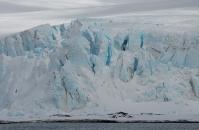WUT’s Mission in the Antarctic
It only takes seven meters for them to lift up in the air and their main goal is to check the population of penguins in the Antarctic and to make an orthophotomap of the researched area. What we are talking about here are the unmanned aerial vehicles (UAVs) constructed by a team from the Institute of Aeronautics and Applied Mechanics (Faculty of Power and Aeronautical Engineering).
A novel approach to monitoring the impact of climate change on Antarctic ecosystems. (Acronim: MONICA) is a project financed by the Polish – Norwegian Research Programme operated by the National Centre for Research and Development.
The main goal of the project is to study impact of climate change on Antarctic ecosystem and biodiversity. The Western Antarctic Peninsula (WAP) is exhibiting rapid regional warming. The study area on King George Island is located in the WAP region. Therefore the climate change poses a new challenge to the survival of Antarctic wildlife. Changes in land and marine ecosystems of the Antarctica result in changes of the range and abundance of the birds and marine mammals, as well as distribution of vascular plants which are an important ecological bioindicators. This project utilizes Unmanned Aerial Vehicles (UAV) to collect baseline geospatial environmental data, which will be used to monitor climate change effects. In particular, we will study selected impacts of climate change on ecosystems and biodiversity, by quantifications of seal, penguin populations, flora distribution and glacier retreats. With the UAV-data we also develop high resolution vegetation maps and study changes in vegetation cover from previous mappings, and we will map new vegetation where glaciers have retreated. Maps demonstrating distribution and condition of biotic and abiotic environmental components will be created. Data collection will take place using UAVs recording data in multiple spectral ranges. An integral part of the study will include developing methods for processing digital multispectral images from various types of sensors carried by the UAVs. Data processing will be based on remote sensing algorithms used on the aerial photogrammetric material as well as on author’s own ground based methods developed by scientists participating in the project.
Using these methods will allow future collection of photogrammetric material without the need to conduct additional ground measurements. All ecosystem changes studied will be related to changes in climate, and the work will lead to a unique UAV-based polar monitoring system, which can be adapted to other polar areas as well.
It is the biggest photogrammetric mission of the UAVs done at the Henryk Arctowski Polish Antarctic Station on the King George Island in the largest of the South Shetland Islands. The Institute of Biochemistry and Biophysics Polish Academy of Sciences is the project promotor whilst team of emploees from WUT’s Faculty of Power and Aeronautical Engineering from the Institute of Aeronautics and Applied Mechanics led by Professor Mirosław Rodzewicz together with a team from the Northern Research Institute Tromsø (NORUT).
Monitoring the wildlife of Antarctica especially the penguins provides us with a lot of information on the condition of the sea ecosystems and can be supportive for a rational maritime economy in order to establish fishing quotas. Krill is what is mostly fished out in that region. The research is supposed to give an answer to a very important question: “how much krill can be fished out without causing disturbance in the ecosystem so that the balance in nature is kept?”.
Two PW-ZOOM UAVs designed especially for such photogrammetric missions by Prof. Rodziewicz from WUT’s Faculty of Power and Aeronautical Engineering. They are equipped with high resolution cameras with image stabilization. The drive unit comprises of two-stroke petrol engines with compression ignition and electronic ignition module. – It is a very practical drive unit for us because of its easy starting. Flat engines doesn’t shake a lot which is important because of a certain vibration tolerance of the autopilot and for the better quality of the photos. Nevertheless, we have additionally installed a vibration-isolation. - explainsProf. Mirosław Rodzewicz. Moreover, the planes have been equipped with radio remote control, photographing system which is basically a camera with a special cover for the lens for the moment of take off and landing as well as a telemetry system. In addition, there is a parachute safety system in case of an emergency.
The first part of the expedition finished in January 2015. Counting the penguins from high above proved to be much quicker and very accurate just like the traditional method where researchers had to pull lines (used as reference lines) in between penguins’ nests then climb up a hill from which they would take a picture. Monitoring of the ASPA-128 area involved 8 trips and took almost 14 days. Prof. Rodziewicz’s team needs only 5 flights of the PW-ZOOM UAV which altogether take up to 5,5 hours. More than 17 000 penguins’ nests were discovered thanks to the new method. The second part of the WUT’s mission in MONICA project started in October 2015.








